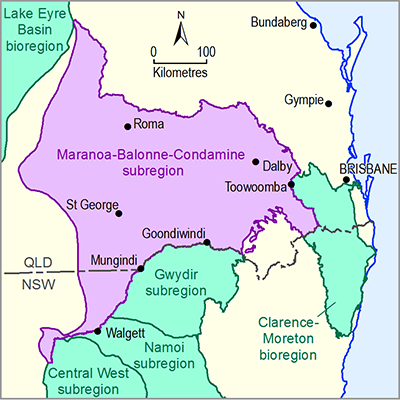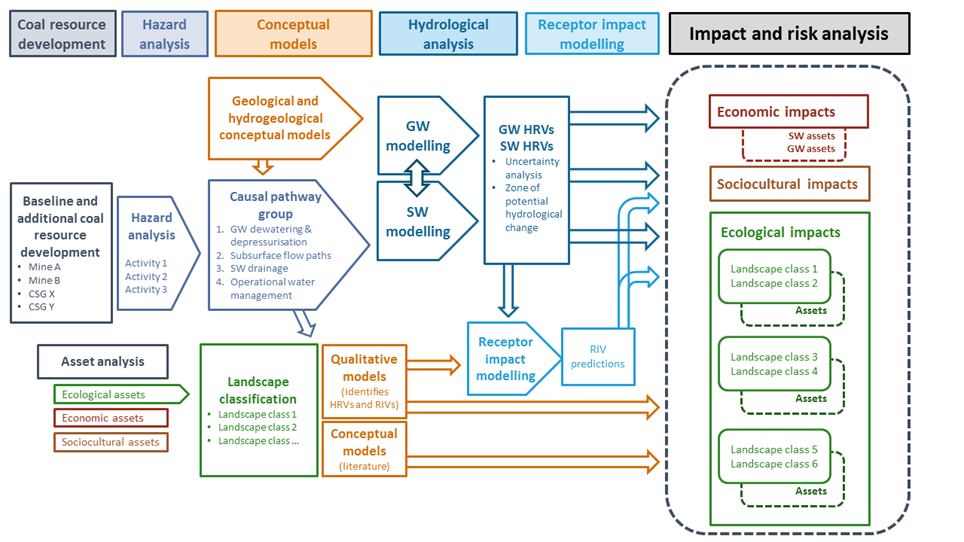The Methodology for bioregional assessments of the impacts of coal seam gas and coal mining development on water resources (the BA methodology) (Barrett et al., 2013) states:
The central purpose of BAs is to analyse the impacts and risks associated with changes to water-dependent assets that arise in response to current and future pathways of CSG and coal mining development.
The impact and risk analysis for the Maranoa-Balonne-Condamine subregion (Component 3 and Component 4) followed the overarching logic described in companion submethodology M10 (as listed in Table 1) for analysing impacts and risks (Henderson et al., 2017), and is summarised diagrammatically in Figure 4. It builds on the contextual information (Component 1) and model-data analysis (Component 2) (as listed in Table 2). The impact and risk analysis represents the culmination of effort to improve the knowledge base around the coal resource development, and to understand how water resources and water-dependent assets may be affected by hydrological changes due to additional coal resource development in the Maranoa-Balonne-Condamine subregion.
The impact analysis quantified the magnitude or extent of the potential hydrological and ecosystem changes due to coal resource development. This included:
- direct impacts: a change in water resources and water-dependent assets resulting from coal seam gas (CSG) and coal mining developments without intervening agents or pathways
- indirect impacts: a change in water resources and water-dependent assets resulting from CSG and coal mining developments with one or more intervening agents or pathways
- cumulative impacts: the total change in water resources and water-dependent assets resulting from CSG and coal mining developments when all past, present and reasonably foreseeable actions that are likely to impact on water resources are considered.
The risk analysis is related, but considered not only the magnitude or extent of the potential impact but also the likelihood of that impact. This is often framed as ‘consequence multiplied by the likelihood’. The quantification of the likelihood was underpinned by a dedicated uncertainty analysis that allowed probabilistic statements to be made about certain events or impacts occurring. Within BAs, the uncertainty analysis stochastically propagated uncertainties in underlying hydrological parameters through hydrological models to produce distributions of potential surface water and groundwater changes. These in turn were input to receptor impact models to produce distributions of receptor impact variables, which were chosen as indicators of potential ecosystem impacts.
BAs identify risks through a hazard analysis and analyse those risks by estimating the magnitude and likelihood of specific impacts. The risk assessment, risk evaluation and the risk treatment that occur as part of the broader risk management (see for instance ISO 31000:2009 Risk Management Standards) are considered beyond the scope of BAs. BAs do not consider a number of non‐scientific matters and value judgements; these are roles of proponents and government regulators in the first instance, and often in response to specific community values.
Throughout this product there is a focus on describing the hydrological changes, and then the potential impacts of those changes to landscape classes and water-dependent assets, which contain ecological, economic and sociocultural values.
BAs present the likelihood of certain impacts occurring, for example, the percent chance of exceeding 5 m of drawdown in a particular aquifer and location. The underpinning data and information are available at www.bioregionalassessments.gov.au for others to use in their own targeted risk assessments. Users can choose thresholds of impact that may threaten the specific values they are trying to protect and calculate the corresponding likelihood of occurrence.
Figure 4 Overarching methodology for impact and risk analysis in bioregional assessments
CSG = coal seam gas, GW = groundwater, HRV = hydrological response variable, RIV = receptor impact variable, SW = surface water

Product Finalisation date
- 3.1 Overview
- 3.2 Methods
- 3.3 Potential hydrological changes
- 3.4 Impacts on and risks to landscape classes
- 3.4.1 Overview
- 3.4.2 Landscape classes that are unlikely to be impacted
- 3.4.3 'Floodplain or lowland riverine (including non-GAB GDEs)' landscape group
- 3.4.4 'GAB GDEs (riverine, springs, floodplain or non-floodplain)' landscape group
- 3.4.5 'Non-floodplain or upland riverine (including non-GAB GDEs)' landscape group
- 3.4.6 'Human-modified' landscape group
- References
- Datasets
- 3.5 Impacts on and risks to water-dependent assets
- 3.6 Commentary for coal resource developments that are not modelled
- 3.7 Conclusion
- Citation
- Acknowledgements
- Contributors to the Technical Programme
- About this technical product

